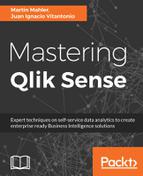Basic Qlik Sense is self-contained and allows you to solve many business intelligence use cases with the use of its load script editor, Qlik expressions, set analysis, and variables. With the full opening up of the Engine to third-party integrations via APIs, there are now unlimited possibilities for how native Qlik functionality can be extended or leveraged by other systems and applications. The world to communicate with the API, though, is with classic programming languages, with .NET and JavaScript in particular. While both frameworks (and many more web languages which support web sockets) are available, this book puts a stronger emphasis on JavaScript. Most examples and implementations are mostly transferable, regardless of which one you choose for your project.
This chapter will discuss and outline the most important JavaScript libraries and code languages required to build extensions and mashups or to integrate Qlik into a separate web app. To warn advanced web developers, the topic will probably be covered on a fairly basic level to allow people with non-development backgrounds to better grasp how these libraries work and why they are important for Qlik projects. As such, this chapter will be very valuable to former QlikView developers who are looking to transition to Qlik Sense but are daunted by JavaScript or any coding languages. While coding is always necessary, it's natural that JavaScript appears to be very complex and difficult at first sight. It's not the intention of the chapter to demystify a legend; JavaScript and its libraries are not a piece of cake, but they can be fairly easy and straightforward if kept on a basic level. Complexity increases as the code becomes more powerful, but on a low level, it's still a sequential execution of a script, with classic conditional statements (if statements), variables, and loop functions, similar to how the Qlik load script works (See Chapter 8, Advanced Scripting).
This chapter aims to give the reader a good understanding of the basic concepts of web development and how HTML5, Cascading Style Sheets (CSS), and JavaScript (or JS) code is read by the browser. Furthermore, it will introduce the most commonly used libraries. It will help you understand the concepts of the most relevant JS libraries for Qlik, enable you to read and write basic code written in JavaScript and show you how to debug web development code in the browser. In particular, it will cover the following topics:
- HTML5
- CSS
- JavaScript
- D3.js
- RequireJS
- AngularJS
After reading this chapter, the goal should be for the reader to be able to identify the purpose of different code snippets in Qlik code, to be able to speak the language of web developers, and to know where to start looking if there's interest to extend the knowledge on these topics or specific libraries even further.
